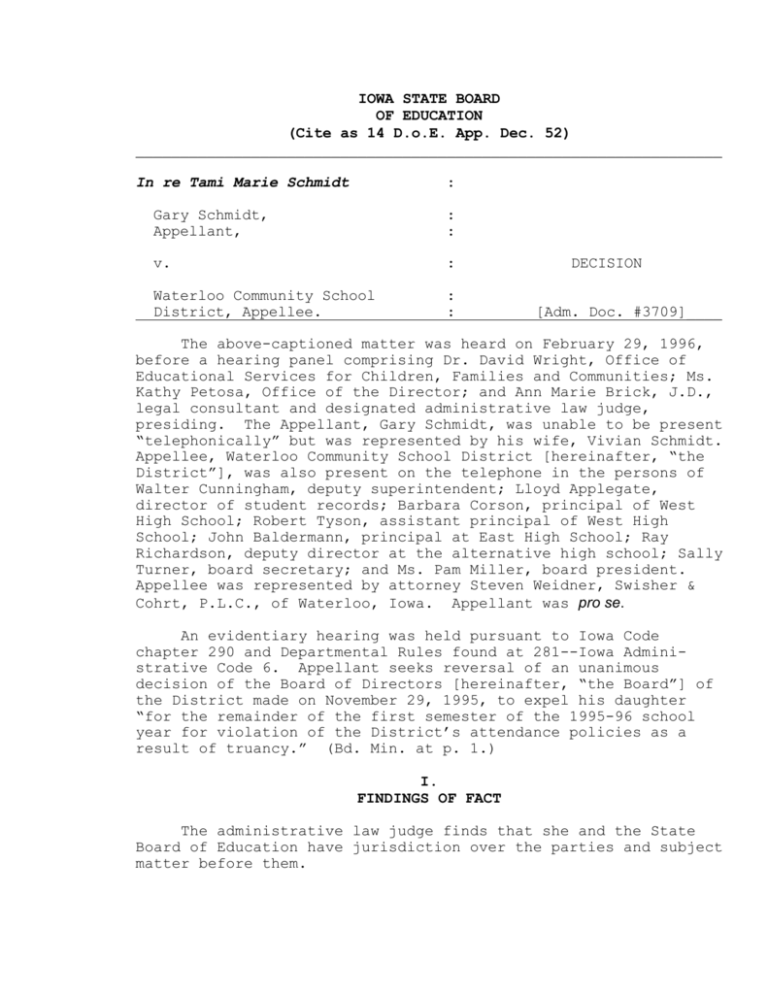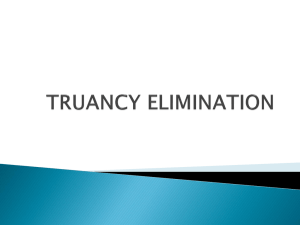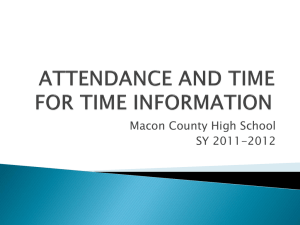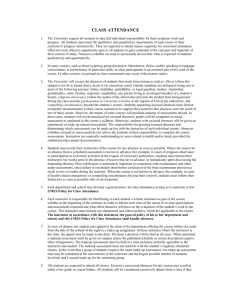SCHMIDT TAMI DECISION - School Administrators of Iowa
advertisement

IOWA STATE BOARD OF EDUCATION (Cite as 14 D.o.E. App. Dec. 52) __________________________________________________________________ In re Tami Marie Schmidt : Gary Schmidt, Appellant, : : v. : Waterloo Community School District, Appellee. : : DECISION [Adm. Doc. #3709]____ The above-captioned matter was heard on February 29, 1996, before a hearing panel comprising Dr. David Wright, Office of Educational Services for Children, Families and Communities; Ms. Kathy Petosa, Office of the Director; and Ann Marie Brick, J.D., legal consultant and designated administrative law judge, presiding. The Appellant, Gary Schmidt, was unable to be present “telephonically” but was represented by his wife, Vivian Schmidt. Appellee, Waterloo Community School District [hereinafter, “the District”], was also present on the telephone in the persons of Walter Cunningham, deputy superintendent; Lloyd Applegate, director of student records; Barbara Corson, principal of West High School; Robert Tyson, assistant principal of West High School; John Baldermann, principal at East High School; Ray Richardson, deputy director at the alternative high school; Sally Turner, board secretary; and Ms. Pam Miller, board president. Appellee was represented by attorney Steven Weidner, Swisher & Cohrt, P.L.C., of Waterloo, Iowa. Appellant was pro se. An evidentiary hearing was held pursuant to Iowa Code chapter 290 and Departmental Rules found at 281--Iowa Administrative Code 6. Appellant seeks reversal of an unanimous decision of the Board of Directors [hereinafter, “the Board”] of the District made on November 29, 1995, to expel his daughter “for the remainder of the first semester of the 1995-96 school year for violation of the District’s attendance policies as a result of truancy.” (Bd. Min. at p. 1.) I. FINDINGS OF FACT The administrative law judge finds that she and the State Board of Education have jurisdiction over the parties and subject matter before them. 53 Beginning with the 1995-96 school year, the Waterloo Community School District’s Board of Directors decided to introduce a restrictive, new attendance policy to stem the tide of absenteeism witnessed during the previous school year. Dr. Cunningham, deputy superintendent, testified that he is the person most involved with the interpretation and enforcement of the policy on a district-wide basis. Although he was not involved in the process himself, he testified that a task force of parents and students did have input during the development of the policy. At each school, the principal or in this case, the assistant principal, is responsible for applying the policy to individual students. The bottom line of the new policy is that students who cut class persistently will be expelled from school. Dr. Cunningham testified that although there could be a lot of expulsions initially, once the students realize that the District is serious about attendance, they will meet these expectations.1 The policy sets different attendance expectations for elementary, intermediate and high school students. During the time giving rise to this appeal, Appellant’s daughter was a ninth grade student at West High School in Waterloo. The policy as it applies in high school, provides that students can be expelled for the semester after the eighth absence (counting excused and unexcused together). Principals can reinstate students on a probationary status in cases of an extended illness. Students can be expelled for the remainder of the semester on the second truancy. Under the terms of the policy, the definition of truancy is: A. Definition of Truancy Truancy is a student’s absence from school or class without the knowledge and consent of either the head of household or the school. A student may be considered truant when he/she: a. fails to report to school without the permission of the head of household. b. arrives at school late (beyond tardy limit fifteen (15) minutes). c. reports to his/her assigned area (classroom or geographical locale where instruction is to be Approximately 66 students were expelled under this policy during the first semester of the 1995-96 school year. There were 28 expulsions for truancy and 38 expulsions for violation of the “total absence rule” (the total number of excused and unexcused absences in any specific class must not exceed eight (8) in a semester.) Of the 66 students expelled during the first semester, five (5) did not return to school second semester. 1 54 given fifteen (15) minutes or more after the class period begins unless being late was evidenced by a pass slip from an administrator or other staff person. d. leaves the building during the school day without first having secured permission. e. receives third (3rd) and subsequent unexcused absence. f. participates in skip days. (The Board of Directors and school administration do not sanction the concept of a skip day. A student’s participation in a skip day will be treated as a truancy according to District policy.) The building administrator and/or the administrator in charge, Division of Student Services, may waive a truancy for good cause. A student who receives a truancy will be required to make up all the missed time in detention after school. The principal or designee will notify the head of household and place the student on probation. Receipt of a second (2nd) truancy will result in the student being dropped from the class. It is possible that the receipt of a second (2nd) truancy could result in a student being dropped from all classes or recommended to the Board for expulsion. Also, students that are not carrying the required academic schedule could be dropped from school or recommended for expulsion. (Policy 1H and Regulation 1H-R(1). Emphasis added.) The principal/designee will provide the head of household with the option to withdraw their student providing the student is sixteen (16) years old prior to September 15.2 A student who is not sixteen (16) years old prior to September 15 will be promptly referred to the Board of Directors with the recommendation for expulsion. Whatever option is chosen, the referral shall be in writing to the administrator in charge, division of student services, with copies forwarded to the student and the student’s head of household. This amounts to an “administrative expulsion.” It means that the student is out of school in the district. Possibly the difference here is that the parents could send their student to another district if they pay tuition. Under an expulsion, a new district does not have to accept the student. 2 (Attendance, Truancy and Tardy Policy, Waterloo Community School District, at pp. 6-7.) 55 When this appeal arose, Tami Marie Schmidt was a 14-year-old freshman at West High School. Although Tami had been a straightA student for most of her life, she did not adjust well to high school. Her mother began to notice behavioral changes at home and declining grades at school. Ms. Schmidt testified that she suspected drug abuse and asked school personnel to call her if they noticed anything unusual. She said she never received a call from the school. In the meantime, Tami’s friends changed and arguments at home became more frequent. Ms. Schmidt confronted Tami and learned that she had been using marijuana. Ms. Schmidt testified that she suspected something more than that because Tami was “really wiped out for quite a while.” On Thursday morning, October 26, 1995, Ms. Schmidt hugged Tami good-bye and told her to have a good day at school. Tami was picked up for school by her friend, Amanda, as was the normal routine. A couple of hours later, Ms. Schmidt received a call from the mother of one of Tami’s friends. This parent told Ms. Schmidt she had heard that Tami, Amanda, and another boy had runaway. Tami’s parents finally found out where she was on the following Tuesday, October 31st. The Schmidts were notified that the police had found the children at the Mexican border, trying to re-enter this country. Tami was taken into custody until Ms. Schmidt could drive down to pick her up on November 4th. After she returned home with Tami on November 6th, Ms. Schmidt was notified that her daughter would be recommended for expulsion. On November 10, 1995, Barbara Corson, West High principal, and Bob Tyson, assistant principal, prepared their written recommendation for Tami’s expulsion because of her “second truancy.” The recommendation to Dr. Cunningham stated that the first truancy occurred on September 19, 1995, when Tami skipped 6th and 7th period classes. Tami’s second truancy occurred from October 26th through November 3rd. The second truancy was described as follows: Student ran away from home. Parent contacted on October 27. Parent considered her truant. Tami was located in Texas on October 31. She was not able to return to Waterloo until November 5. The student missed 7 full school days. (Appellee’s Exh. Fax at 13.) The recommendation also noted that the parent was contacted by phone and in person on November 6, 1995, when the administra- tion notified the Schmidts that Tami would be recommended for expulsion. 56 The evidence showed that in accordance with the policy, Tami had signed a “truancy probation” after cutting two of her classes on September 19th (the first truancy). The statement she signed acknowledged that if she was “truant for a second time from any class, assigned area, or from school, a referral will be made to the Board of Directors with the recommendation for expulsion from school.” (Appellee’s Exh. Fax at 13.) Mr. Tyson testified that it was his understanding that he had no choice other than to recommend expulsion. “When a student chooses to leave for that length of time ... as administrators, we have to follow Board policy. Board policy simply says on the second truancy, we have to recommend expulsion -- no matter where our personal feelings are. ...”3 Tami was expelled for the remaining part of the semester on November 29, 1995. Six other expulsions, all from West High School, were also unanimously approved at that same board meeting. Tami returned to school on January 17, 1996. During the time she was expelled, she went to a psychologist and completed a correspondence course through Kirkwood Community College, receiving a grade of “B.” Ms. Schmidt complained at the hearing that few resources are available for expelled students in Waterloo. The evidence showed that if a student is under sixteen (16) years of age, the Kirkwood Community College correspondence course is about the only option available to them. Hawkeye Community College does not accept students under sixteen (16) years of age. The Educational Discipline Center (EDC), an alternative program in the District, will not accept students who have been suspended, expelled, or have truancy or attendance problems. In addition, there is no drug intervention program in Waterloo. Dr. Cunningham testified that pursuant to Board policy, all students’ records are purged of the courses they are taking under the semester of expulsion but no failing grades are awarded. In addition, Dr. Cunningham stated that it is fairly simple for a student to make up the courses missed because of expulsion since “it only takes 38 credits to graduate and they can earn 56 credits throughout their high school career.” We do not fault the administration for their application of the policy. We would just note that under the policy, arriving at school late “beyond tardy limit -- fifteen (15) minutes,” is considered a truancy. See, Definition of Truancy A(6), Appellee’s Exh. Fax at 8. Two such tardies, and the student would be subject to expulsion at West High School. 3 Board president Pam Miller was present to testify in support of the policy. She stated that the School Board does not want to expel students, but daily attendance rates were not acceptable 57 and something had to be done. In her opinion, the policy has been successful in the District. Ms. Miller testified that it is not the teachers’ duty to police the students. It is the law that students attend school. If parents are unsuccessful in getting their students to attend school, then “the law recognizes expulsion may be necessary.” In rebuttal, Ms. Schmidt stated that they felt that they had just gotten Tami under control when the District expelled her “and refused to educate her.” She testified that it seemed contradictory to her that “in criminal court, they treat each case individually; while in the schools, every student is treated exactly the same.” II. CONCLUSIONS OF LAW In hearing appeals brought under Iowa Code section 290.1, the State Board has been directed by the Legislature to render a decision which is “just and equitable,” “in the best interest of the affected child,” and “in the best interest of education.” See, Iowa Code sections 290.3, 282.18(20), and 281—IAC 6.11(2). The test is reasonableness. Based upon this mandate, a local school board’s decision will not be overturned unless it is “unreasonable and contrary to the best interest of education.” In re Jesse Bachman, 13 D.o.E. App. Dec. 363 (1996). It is an often stated legal axiom in Iowa that when a school board adopts a policy for the operation of its schools, the policy is presumed to be reasonable. The burden of proving the policy unreasonable is upon those challenging the policy. In re Sandra Mitchell, 1 D.P.I. App. Dec. 201, 204 (1978)(citing, Board of Directors v. Green, 147 N.W.2d 854 (1967). In the present case, the Appellant has overcome this presumption of reasonableness. We find that the District’s policy of expelling students upon their second truancy is not reasonable on either legal or educational grounds. See, 281--IAC 6.11(2);4 see, also, In Re Debra Miller, et al., 13 D.o.E. App. Dec. 302, 315-318 (1996). STATE BOARD PRECEDENT: Since 1977, when the Department (then the Department of Public Instruction) began recording chapter 290 appeal decisions, “The decision shall be based on the laws of the United States, the State of Iowa, and the regulations and policies of the Department of Education and shall be in the best interest of education.” Id. (Emphasis added.) 4 the State Board has decided nine (9) attendance policy cases. Because the most recent appeal was decided more than four (4) 58 years ago, it may be helpful to review the principles established by the State Board in attendance policy cases over the past nineteen (19) years in chronological order: In re Laurie Stodgell, 1 D.P.I. App. Dec. 128 (1977). The New London Community School District attendance policy provided that “[i]f a student is absent for more than 12 days per semester in a given class, the student is subject to loss of credit in that subject for the semester. Any extenuating circumstances will be taken into account by the teacher and principal in rendering a decision when needed.” A married teenage mother of two was determined to have accumulated too many absences. She argued that she should not be dropped from class because she missed school due to the illnesses of her children. She appealed the principal’s refusal to recognize her “extenuating circumstances.” While affirming the local board's decision not to find "extenuating circumstances," the State Board noted problems with the District's attendance policy because of its failure to distinguish between “excused” and “unexcused” absences in computing the 12 day limit per semester. In re Sandra Mitchell, 1 D.P.I. App. Dec. 201 (1978). The Baxter Community School District attendance policy provided that “[a] student who is absent from a class more than five (5) times during a semester shall be dropped from the class and receive no credit. ... Absences specifically excused by a medical doctor or dentist will not be counted among the five(5) days described above.” The State Board invalidated the District’s attendance policy stating it was "unreasonable and violates Constitutional procedural due process." The State Board further found that the District policy in question was not based upon good educational principles. In re Richard Caruth, 3 D.P.I. App. Dec. 67 (1982). The Howard-Winneshiek Community School District’s attendance policy allowed students nine absences from class each semester. Students who exceeded the nine-absence limitation would loose credit for the missed classes. The State Board reversed the district board because the "[a]pplication of the District absence policy ... actually resulted in [a student] being punished for being ill." The State Board noted that its decision in In re Sandra Mitchell and the “law and logic discussed therein preclude a school district from taking disciplinary action against a student for absence from school due to illness.” In re Barbara Hay, 4 D.P.I. App. Dec 67 (1985). The State Board overturned as unreasonable an attendance rule requiring 59 either an in-person appearance by a parent or a written note from a doctor to excuse an illness. The high school attendance policy set a limit of six unexcused absences after which the student would be penalized by a loss of credit. Because of the mother’s out-of-town work schedule, it was impossible for her to comply with the in-person appearance to obtain the “excused” absence to avoid the penalty of the policy. In re Donald and Katherine Blaess, 4 D.P.I. App. Dec. 118 (1985). The issue in this case was the question of who decides "unexcused" or "excused" absences. The State Board affirmed the local board's decision that the district defines "excused" versus "unexcused" absences under its attendance policy. In re Korene Merk, 5 D.o.E. App. Dec. 270 (1987). While not strictly an attendance-policy case, the student was expelled for a semester after being found guilty of three separate violations of school rules: two truancies and smoking on school grounds. The State Board reversed the expulsion because the disciplinary policy was not properly applied and because it was fundamentally unfair. “The punishment did not fit the crime.” Statement of the State Board of Education concerning academic sanctions or penalties imposed for student misconduct (October 15, 1987). This official position statement issued by the State Board consists of ten “principles.” These guidelines are intended “to encourage school districts to deal with student misbehavior with an eye toward educating students and redirecting their conduct rather than removing them from the school environment, except in serious situations.” Recommendation no. 6, for example, states that “[a]ny distinction between approved/excused or unapproved/ unexcused absences should not affect a student’s grade, the potential for credit, or right to make up missed assignments ...” Id. In re Lorene Segerstrom, 9 D.o.E. App. Dec. 38 (1991). The Ida Grove Community School District’s absence policy provided that a student who was absent eleven (11) or more days per semester in a class would receive no credit for that semester. The policy was invalidated as “unfair and unreasonable and inconsistent with sound educational policy,” because it combined excused and unexcused absences in the eleven (11) absence total. This decision reviewed prior State Board 60 precedent and stated unequivocally that “no attendance rule which denies credit to a student for excessive absences will be upheld unless the excessive absences are for unexcused reasons or truancy.” In re Troy Wallis and Richard Kaufman, 9 D.o.E. App. Dec. 80 (1991). The attendance policy in question provided that after a student missed ten (10) times during a semester, a conference must be held between the student, teacher, and principal to determine whether the student will be granted an extension of absences allowed or recommended for expulsion upon the 11th absence. The merits (and deficiencies) of the attendance policy were discussed, and the case was remanded to the local board to afford the parties due process and reconsideration under prior State Board precedent. In re Shane Manning, 9 D.o.E. App. Dec. 260 (1992). The attendance policy of the New London Community School District provided that after eight absences per semester in a given class, the student would be subject to loss of credit in that class for the semester. Excused and unexcused absences were lumped together under the policy. If the ninth absence was due to a “valid reason,” it would be excused. The policy was found “unreasonable” as practically indistinguishable from the facts of the Segerstrom case. The State Board has consistently taken the position that students should not be disciplined for absences that are excused. To sanction students for attendance infractions which are unavoidable (such as illness) has been deemed unreasonable. What is not clear from these decisions, is the extent that district policies can impose academic sanctions upon students who have excused or unexcused absences. The 1987 Statement of the State Board, supra at 59, states that the distinction between excused and unexcused absences “should not affect a student’s grade, the potential for credit, or right to make up missed assignments … .” Id. This would indicate that an attendance policy which denied a student course credit or “dropped the student” from a class because of excessive absences, would be invalidated by the State Board on appeal. However, subsequent to the 1987 statement, a decision was rendered which stated: “No attendance rule which denies credit to a student for excessive absences will be upheld unless the absences are for unexcused reasons or truancy. In re Lorne Segerstrom, 9 D.o.E. App. Dec. 38, 44 (1991)(emphasis added). In the most re- cent attendance policy appeal, the Segerstrom case was referred to but clarified as follows: “We have accepted, for the 61 sake of discussion, that an attendance rule can result in loss of credit. We do not wish to be understood as advocating that particular penalty.” In re Shane Manning, 9 D.o.E. App. Dec. 260, 263 n.2 (1992)(emphasis in original). Although the loss of credit for unexcused absences was not “advocated,” it was not prohibited. As a result, it appears that many Iowa school districts have adopted attendance policies that deny course credit as a penalty for absenteeism. Recent court decisions reflect some division on this practice.5 Although court cases involving challenges to grade reduction for absences generally find fault with such policies, each decision seems to be grounded on a somewhat different rationale. Most of the courts have found that grade reduction policies for absences are ultra vires, or beyond the school board’s authority to promulgate. See, “High School Grade Reductions for Absenteeism: Incentive or Curse?” Cooley Law Rev., Vol. VI, 129, 142 (1989). COURT DECISIONS: In Katzman v. Cumberland Valley School Dist., 84 Pa. Cmwlth. 474, 479, A.2d 671 (1984), a student was suspended for five (5) days, excluded from classes, expelled from the cheerleading squad, prohibited from taking part in school activities during suspension, and later permanently expelled from the National Honor Society for drinking wine while on a field trip. Id. 479 A.2d at 671. Under the school’s disciplinary policy, a further penalty, a grade reduction was imposed. The policy stated: Suspensions and expulsions ... Reduced grades in all classes two percentage points each day of suspension. The grades are to be reduced during the marking period when the in-school or out-of-school suspension occurred. In lieu of a two percentage point reduction, the Two cases from Michigan and Connecticut, say school boards may reduce grades for absenteeism under certain circumstances. Slocum v. Holton Board of Education, 171 Mich. App. 92, 429 N.W.2d 607 (1988); Campbell v. Bd. of Ed. of New Milford, 475 A2d 289 (Conn. 1984). Six other decisions invalidated policies which used suspension, expulsion or grade reduction as a penalty for absences. Smith v. School City of Hobart, 811 F.Supp. 391 (N.D.Ind. 1993); Katzman v. Cumberland Valley School District, 84 Pa.Cmwlth. 474, A.2d, 671 (1984); Gutierrez v. School Dist. R-1, 41 Colo. App. 411, 585 P.2d 935 (1978); Dorsey v. Bale, 521 S.W.2d 76 (Ky. App. 1975); Hamer v. Bd. of Educ., 383 N.E.2d 231 (Ill. 1978); Blackman v. Brown, 419 N.Y.S.2d 796 (Sup. Ct. 1978); see, also, J. Price, A. Levine, & E. Cary, The Rights of Students (3d. ed. 1988). 5 62 student may be assigned to a supervised Saturday work program provided the parent(s) and student accept the conditions of this option. Id. at 671-72 The plaintiff was advised that as a consequence of her suspension, her grades in each subject of the entire second marking period would be reduced by ten points; two points for each day of suspension and that the Saturday work provision was not available to her. The Pennsylvania State Board of Education had in force a regulation that provided, “students shall be permitted to make up exams and work missed while being disciplined by temporary or full suspension within guidelines established by the board of school directors.” Id. at 674 n.4. The plaintiff argued that the school board’s regulation was inconsistent with the board of education’s regulation. The court of appeals agreed. The court was then forced to decide the legality of the school board policy, which was not specifically authorized or described by statute or regulation. Yet, the school board policy penalized educational standing for infractions which were not education-related. Relying on the state board’s policy to make up class work during suspension, the court stated that downgrading for non-academic related conduct is a “clear misrepresentation of the student’s scholastic achievement. Misrepresentation of achievement is equally improper and, we think, illegal whether the achievement is misrepresented by upgrading or by downgrading, if either is done for reasons that are irrelevant to the achievement being graded. For example, one would hardly deem acceptable an upgrading in a mathematics course for achievement on the playing field.” Id. at 674-75. The court held that the board’s policy exercised in this manner represented an illegal application of its discretion, and accordingly the grade reduction was improper. The most helpful decision in terms of the policy at issue in this case is Campbell v. Bd. of Ed. of New Milford, 475 A.2d 289 (Conn. 1984). In Campbell, students challenged the policy of a local school board that imposed academic sanctions for nonattendance upon high school students. Although the court found that the policy fell within the authority granted to local boards under Connecticut’s general education law, and upheld the policy, the court’s decision was a narrow one. After reviewing all of the aspects of the policy as drafted by the board, and after distinguishing policies from other states that had been held invalid, the court concluded that the New Milford policy was carefully drafted and fairly applied. The factors important to the court which were present in the decision to uphold the New Milford policy were: 63 I. The purpose of the policy was educational, rather than disciplinary. “A student’s disciplinary suspension from school, for reasons unrelated to attendance, is considered an approved rather than an unapproved absence. Such an absence cannot result in the diminution of a class grade although it may be counted, unless waived, as part of the twenty-four maximum absences for class credit.6 A student’s absence from school, whether approved or unapproved, is not a ground for suspension or expulsion.” Id. at 291(if this is added). II. The report card clearly shows if grades have been reduced for absences. “The report card conspicuously bears the following legend: ‘a circled grade indicates that the grade was reduced due to unapproved absences.’” In addition it is possible to calculate how much reduction has been made because the number of absences are listed along with the percentage reduction for each absence. Id. at 291. In distinguishing the out-of-state cases argued by plaintiff-student, the court noted that the New Milford policy, unlike the cited cases, does not reduce a student’s grade for nonattendance as an additional punishment for unrelated conduct leading to a suspension from class. Id. at 293 (citing, Gutierrez v. School Dist. R-1, 585 P.2d 935 (Colo. 1978); Dorsey v. Bale, 521 S.W.2d 76 (Ky. App. 1975). In addition, the court stated that “[i]t would finally be troublesome to bar a truant student from further class attendance and from taking a final examination.” (Citing, Blackman v. Brown, 419 N.Y.S. 2d 796 (S.Ct. 1978).) The New Milford policy "neither removes such a student from class or excuses further compliance with the state’s compulsory education law.” Id. 293-94. After reviewing the educational policies discussed in the above-referenced judicial decisions, as well as the precedent es- The New Milford policy provides that course credit is withheld from any student who, without receiving an administrative waiver, is absent from any yearlong course for more than twenty-four class periods. In the calculation of the twenty-four maximum absences, all class absences are included. ... Id. at 290. 6 tablished by district attendance policy appeals, the State Board believes it is incumbent upon it to outline the principles that 64 should guide districts as they develop attendance policies at the secondary level.7 These should be understood to be “guiding principles,” not “inflexible requirements.” By articulating these principles, the State Board hopes to provide guidance on what it feels are reasonable and educationally prudent attendance policies.8 EDUCATIONAL NEED AND ATTENDANCE Since there are distinctive considerations involved in secondary attendance policy issues that are different from attendance issues at the elementary level, these “principles” will focus on the secondary school only. (e.g. control of student attendance behavior by the parent is diminished at the secondary level. In addition, all of the appeals to the State Board have been attendance issues at the secondary level.) It is expected that a district’s attendance policy will differentiate between elementary and secondary students. NOTE: These “principles” focus on attendance issues of general education. A discussion of the legal principles that apply to students with disabilities that have been identified under the IDEA is beyond the scope of these guidelines. 7 Remember, the Department’s Administrative Rules require school districts to involve parents, students, instructional and noninstructional professional staff and community members when developing or revising student responsibility and discipline policies. 281—IAC 12.3(8). The State Board will look more favorably upon a district’s attendance policy if it reflects the input of all of these “stake holders.” 281—Iowa Administrative Code section 12.3(8) provides as follows: 8 The board shall adopt student responsibility and discipline policies. In developing or revising such policies, the board shall involve parents, students, instructional and noninstructional professional staff, and community members. Student responsibility and discipline policies shall relate to the educational purposes of the school or school district. The policies shall include, but need not be limited to, attendance; use of tobacco and the use or possession of alcoholic beverages or any controlled substances; violent, destructive, and seriously disruptive behavior; suspension, expulsion, emergency removal, corporal punishment, and physical restraint; out-of-school behavior; participation in extracurricular activities; academic progress; and citizenship. In developing and applying student responsibility and discipline policies, the board shall ensure due process rights for students and parents. In some instances this may require developing separate policies for students who have been identified as requiring special education programs and services. The board shall also consider the potential of a disparate impact on students by virtue of race, sex, disability, or national origin. The board shall publicize its support of these policies; its support of the staff in enforcing them; and the staff’s accountability for implementing them. 1. A school district’s primary obligation is the education of its students. 65 2. It is increasingly clear that districts must exercise reasonable responsiveness to accommodate a wide range of learning needs in order to best support academic success. 3. Because a student’s unwillingness to attend school may be caused by his or her limited academic success, school districts are obligated to provide reasonable educational alternatives or supports for those students at risk of not succeeding academically. (See footnote 10, page 67). DISCIPLINE AND ATTENDANCE 4. School districts have an obligation to provide a learning environment that is safe and orderly to support the academic success of all students. This means that school districts must set reasonable expectations for student behavior, including school attendance, and may impose reasonable sanctions when those expectations are not met, subject to provision of legal due process. (See footnote 8, page 64). 5. For a secondary student, failure to attend school may be considered as behavior that is subject to disciplinary sanctions. It is recognized that, for secondary students less than 17 years of age and their parents, school attendance is a legal obligation. It is also recognized that teachers and other school staff that must accommodate students who are unnecessarily absent may have less time to respond to the needs of students who are more regular in their school attendance. 6. Students should not be subject to sanctions for failure to attend school if lack of attendance is beyond the control of the student. Some absence should be excused without disciplinary penalty. Illness, school sponsored trips, or “unavoidable” occurrences would be examples of excused absences. It is also reasonable to require a doctor’s verification of the illness in some circumstances. It is not reasonable to do so in every case since to do so may work a hardship on families with limited or no insurance or families with working parents. Additionally, if a student has frequent absences or prolonged absences due to illness, the district is advised to determine whether or not the student has a handicap or disability under the provisions of Section 504 of the Rehabilitation Act of 1973. 7. School districts may define by policy what are excused and unexcused absences. The determination of whether an absence is 66 excused is made by the school, not by the parent. In re Donald and Katherine Blaess, 4 D.P.I. App. Dec. 118 (1985). 8. In order to facilitate practical administration and to facilitate the communication of district student expectations, the district may adopt a number of “allowable” unexcused absences. Five to seven absences per semester would not seem to be unreasonably low, although this number must be set locally. 9. Excused and unexcused absences should not be combined for the imposition of sanctions under an attendance policy. 10. Absences should not include suspensions or classes missed because of attendance at a school-sponsored trip or activity. 11. The policy should provide reasonable administrative flexibility in the administration of disciplinary action. Administrators should be given and are expected to use judgment in the determination of excused versus unexcused absences and also in the imposition of a range of sanctions for lack of attendance. The sanctions should be imposed within the parameters established by the requirements of substantive and procedural due process.9 a. Procedural due process requires that the policy be clearly written so that parents and students understand what behavior is unacceptable. The policy must be properly adopted by the district board and disseminated to parents and students. b. Substantive due process requires that the attendance policy be fair and reasonable. It requires that there be a legitimate relationship between the punishment and the misconduct. ACADEMIC CREDIT OR GRADE REDUCTION AND ATTENDANCE 12. Significant lack of attendance in a course of study might reasonably be expected to negatively affect academic performance which would negatively affect a student’s grade in that course. Grade reductions may result from absences in the following situations: Administrators should be careful to exercise their discretion fairly when they determine whether a particular student’s absence should be deemed excused or unexcused. 9 67 a. Failure to attend make-up sessions as assigned for the completion of make-up work; b. If points or percentages for attendance and participation are given, the denial of those points or percentages for absenteeism is a reasonable practice. (1987 St. Bd. Pol., par. 10.) c. Additional work may be assigned to compensate for class time lost due to absences. However, the failure to complete make-up assignments satisfactorily within a reasonable time is a separate act and constitutes grounds for reduced credit. (1987 St. Bd. Pol., par. 6.) d. The report card should indicate whether grades have been reduced for absences. This answers the criticism that a district’s grading system is a misrepresentation of the students’ academic achievement. 13. An attendance policy may provide that students will receive no credit after exceeding a number of unexcused absences. Any attendance policy providing that students may be “dropped” from a class because of excessive unexcused absences should make reasonable provisions for alternative classes or activities within the parameters of the district’s resources. a. This recognizes that the primary purpose of the policy is educational rather than disciplinary. This also recognizes that the “reasonableness” of alternative programs or activities will vary with district resources. A large district might provide a “night school” program; while a small district might require participation in community service or Saturday tutoring sessions.10 Iowa Code subsections 256.9(31-33) require districts to identify at risk students and develop programs to meet their needs. After developing an attendance policy, the district should collect and analyze suspension, attendance, and truancy data by socioeconomic status, special needs, race, gender, grade level, school building and classroom. This should help the district in identifying students who are at-risk. It can also identify whether the policy has a disparate impact on certain subgroups. 10 b. The total number of absences which result in being dropped from a class or being given “no-credit” should be “reasonable.” This recognizes that sometimes there is no 68 other “remedy,” but districts should not make it easy for students to circumvent the Compulsory Attendance Law by expelling them. Dropping a student from a program after fewer than five or six absences appears to be an unreasonable sanction. 14. The attendance policy should be reviewed at least every three years as required by 281—IAC 12.3(2). As part of this ongoing review process, boards are required to consider the potential that the attendance policy imposes a disparate impact on students by virtue of race, sex, disability, or national origin as required by 281—IAC 12.3(8). CONCLUSION: The immediate issue in this appeal concerns the reasonableness of Appellant’s expulsion under the District Board’s attendance policy. We must reverse the expulsion on the grounds that the Waterloo attendance policy is unreasonable and contrary to established State Board precedent. As stated earlier, the School Board has the legal authority to adopt policies requiring attendance for a specified number of days as well as defining by that policy which absences shall be excused and which shall be unexcused. See, Iowa Code section 299.1 (1995). It is then presumed that the policy adopted is reasonable “and the burden of proving the policy unreasonable rests upon those challenging it.” In re Barbara Hay, 4 D.P.I App. Dec. 67, 71 (1985)(citing, Bd. of Directors v. Green, 259 Iowa 1260, 147 N.W.2d 854 (1967). In the present case, we feel that Ms. Schmidt has sufficiently overcome this presumption and that the District’s attendance policy is not reasonable on legal or educational grounds. The policy circumvents legislative policy under the Compulsory Attendance Law. Iowa Code chapter 299 provides the following remedies for truancy: First, school officers should attempt to find the cause for the truancy. Id at 299.5A. This does not suggest that a school board define a “truancy” in very restrictive terms (e.g. a 15-minute tardy) and then expel a student after the second infraction. The second step envisioned by the legislature, after attempting to find out why the student is truant, is to work with the parents to get the student to school. When this proves unsuccessful, as it often does at the secondary level, the school “shall refer the matter to the county attorney for mediation or prosecution.” Id. 299.5A. The expulsion of a student under Waterloo’s procedure ignores the legislative pref- erence to at least attempt to serve the “at-risk” student. 281--IAC 12.5(13) Provisions for At-Risk Students. See, 69 When a prima facie case of unreasonableness is made out, the burden shifts to the Board to justify its policy. In this case, the District’s reasoning, while laudable in purpose and intent, failed to overcome the unreasonableness of the policy. Therefore, the policy must fail. All motions or objections not previously ruled upon are hereby denied and overruled. III. DECISION For the foregoing reasons, the decision of the Board of Directors of the Waterloo Community School District made on November 19, 1995, to expel Tami Schmidt for the remainder of the first semester is recommended for reversal. There is no remedy for Tami Schmidt’s loss of credit for the first semester. However, the District Board is advised that its attendance policy is unreasonable because it expels students from school on a second truancy and after an eighth absence for the remainder of the semester. The District Board should revise its policy within the parameters of the legal principles and educational considerations outlined herein. There are no costs to this appeal to be assigned. _____________________________ ________________________________ DATE ANN MARIE BRICK, J.D. ADMINISTRATIVE LAW JUDGE It is so ordered. ____________________________ DATE _________________________________ C.W. CALLISON, ACTING PRESIDENT STATE BOARD OF EDUCATION






